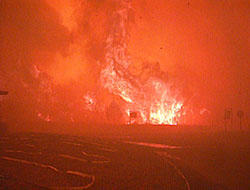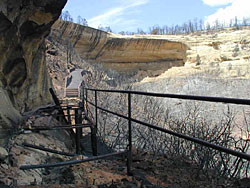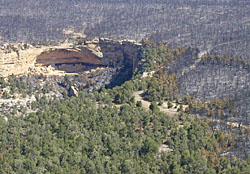
|
|
As the Flames Die Down
|
October 19, 2000
|
|
by Carolyn Swan
|

Flames threaten Morefield Campground.
(Pete Blume, BLM Grand Junction, CO)
Post-wildfire studies may reveal as many as 1,000 new ancestral Puebloan sites in Mesa Verde National Park, Colorado, after a summer fire season of epic proportions. The Bircher Fire (July 21-29) and the Pony Fire (August 4-11) were both ignited by lightning striking areas near the park, the former burning 23,607 acres and the latter some 5,240 acres. The two fires combined ravaged 40% of the park.

Kern Valley firefighters tie in line.
(Courtesy Kern Valley Hotshots) | Firefighters worked hard to contain the fires before archaeological sites were damaged. The job was difficult because of inaccessible terrain, low humidity levels, high temperatures, and unpredictable winds. Many firefighters on the job were also archaeologists, who identified sites, both old and new, in the path of the proposed firebreaks (barriers of cleared or plowed land that limit the spread of a fire); if alternative firebreak routes could not be taken, archaeologists recorded and mapped as much data as possible before bulldozers came through. "Sites identified range from a pile of lithic materials to actual structures like the kiva found during the Chapin #5 fire of 1996," notes Will Morris, public affairs officer of the Park. "There is a full [chronological age] spectrum represented, from A.D. 750 to 1300." |
There are 1,388 known sites within the burned area of the park. Because ancient buildings in the area are made of sandstone, the fire was capable of significant damage. According to Morris, the intense heat of fire causes spalling in sandstone. "The rock is so superheated that it can explode--popping off sections like puzzle pieces," he explains. Although the entire park was threatened, little serious harm came to any of the major attractions; the fires remained about three miles away from Cliff Palace and Balcony House, two of the park's better-known sites. Fires burned all sites on Wetherill Mesa, coming right up to the doorsteps of Long House and Step House, two important cliff dwellings, after destroying modern-day facilities including rest rooms and the ranger station. Step House, a site unique because of evidence of two separate occupations on the same site (A.D. 626 and 1226), suffered some spalling of its alcove ceiling.

Long House and burned bridge
(Pete Blume, BLM Grand Junction, CO) | 
Step House
(Pete Blume, BLM Grand Junction, CO) |
Besides damage to sandstone architecture, artifacts were greatly affected. "The charring of pottery sherds throws off the dating techniques we use, because these techniques use heat," reports National Park Service archaeologist and rehabilitation director Jane Anderson.
Work is far from over, despite the fires having been contained months ago. A Burned Area Emergency Rehabilitation (BAER) Team--organized by the Department of the Interior and composed of biologists, archaeologist, soil scientists, geologists, foresters, and other professionals--will be working for up to three years to evaluate and mitigate the situation. Their focus is on both natural and cultural resources. The worst problem the team faces is erosion. "The key is to get water away from the sites," says Morris. Workers are creating channels and dams as well as trying to break down the fire-traumatized soil so it will accept water. "Six thousand acres of land destroyed by the Bircher Fire are being reseeded with native species to slow erosion," Morris continues. If water does not absorb into the ground, then it flows over the land, down slopes, and washes away archaeological remains.

Wetherill Mesa, close up of archaeological site shelter
(Pete Blume, BLM Grand Junction, CO) | 
Long House cliff dwelling since the Pony Fire
(Pete Blume, BLM Grand Junction, CO) |
In addition to protecting sites, scientists will have to account for new finds. "It is not uncommon to get site densities of anywhere from 10 to 50 sites per square mile in well-surveyed locales of the Mesa Verde region, so you can imagine that there is going to be a lot of archaeology that will need to be reexamined," notes Richard Wilshusen, curator of anthropology at the University of Colorado Museum in Boulder. It is hoped that new sites will help answer questions about the life of the ancestral Pueblo people who inhabited and subsequently abandoned the sites around A.D. 1300. Wilshusen points out that the Chapin #5 fire exposed some 436 new sites "and it covered much less acreage."
"The funding we have now is for the emergency assessment of damage and rehabilitation of known sites," notes Anderson. To begin studying and documenting new sites is a whole other issue and will begin once the BAER team has completed its work. "We are currently searching for the funding to research new sites," says Anderson.
For more information about Mesa Verde and the fires, visit www.nps.gov/meve and www.nifc.gov.
Carolyn Swan is a student at Dartmouth College and an intern with ARCHAEOLOGY.

© 2000 by the Archaeological Institute of America
archive.archaeology.org/online/features/fire/ |

